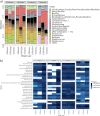Bacterial Diversity on Historical Audio-Visual Materials and in the Atmosphere of Czech Depositories
- PMID: 37428069
- PMCID: PMC10434117
- DOI: 10.1128/spectrum.01176-23
Bacterial Diversity on Historical Audio-Visual Materials and in the Atmosphere of Czech Depositories
Abstract
Microbial contamination in cultural heritage storage facilities is undoubtedly still a huge problem and leads to the biodeterioration of historical objects and thus the loss of information for future generations. Most studies focus on fungi that colonize materials, which are the primary agents of biodeterioration. However, bacteria also play crucial roles in this process. Therefore, this study focuses on identifying bacteria that colonize audio-visual materials and those present in the air in the archives of the Czech Republic. For our purposes, the Illumina MiSeq amplicon sequencing method was used. Using this method, 18 bacterial genera with an abundance of higher than 1% were identified on audio-visual materials and in the air. We also evaluated some factors that were assumed to possibly influence the composition of bacterial communities on audio-visual materials, of which locality was shown to be significant. Locality also explained most of the variability in bacterial community structure. Furthermore, an association between genera colonizing materials and genera present in the air was demonstrated, and indicator genera were evaluated for each locality. IMPORTANCE The existing literature on microbial contamination of audio-visual materials has predominantly used culture-based methods to evaluate contamination and has overlooked the potential impact of environmental factors and material composition on microbial communities. Furthermore, previous studies have mainly focused on contamination by microscopic fungi, neglecting other potentially harmful microorganisms. To address these gaps in knowledge, our study is the first to provide a comprehensive analysis of bacterial communities present on historical audio-visual materials. Our statistical analyses demonstrate the critical importance of including air analysis in such studies, as airborne microorganisms can significantly contribute to the contamination of these materials. The insights gained from this study are not only valuable in developing effective preventive measures to mitigate contamination but also valuable in identifying targeted disinfection methods for specific types of microorganisms. Overall, our findings highlight the need for a more holistic approach to understanding microbial contamination in cultural heritage materials.
Keywords: Illumina MiSeq; air contamination; audio-visual materials; bacterial contamination; cultural heritage.
Conflict of interest statement
The authors declare no conflict of interest.
Figures





References
-
- Tepla B, Demnerova K, Stiborova H. 2020. History and microbial biodeterioration of audiovisual materials. J Cult Herit 44:218–228. doi: 10.1016/j.culher.2019.12.009. - DOI
-
- Branysova T, Demnerova K, Durovic M, Stiborova H. 2022. Microbial biodeterioration of cultural heritage and identification of the active agents over the last two decades. J Cult Herit 55:245–260. doi: 10.1016/j.culher.2022.03.013. - DOI
-
- Zhang GX, Gong CJ, Gu JG, Katayama Y, Someya T, Gu JD. 2019. Biochemical reactions and mechanisms involved in the biodeterioration of stone world cultural heritage under the tropical climate conditions. Int Biodeterior Biodegradation 143:104723. doi: 10.1016/j.ibiod.2019.104723. - DOI
-
- Borrego S, Guiamet P, de Saravia SG, Batistini P, Garcia M, Lavin P, Perdomo I. 2010. The quality of air at archives and the biodeterioration of photographs. Int Biodeterior Biodegradation 64:139–145. doi: 10.1016/j.ibiod.2009.12.005. - DOI
-
- Branysova T, Tepla B, Demnerova K, Stiborova H, Durovic M. 2021. Biodeterioration of audio-visual materials. Chem Listy 115:260–265.
Publication types
MeSH terms
LinkOut - more resources
Full Text Sources

